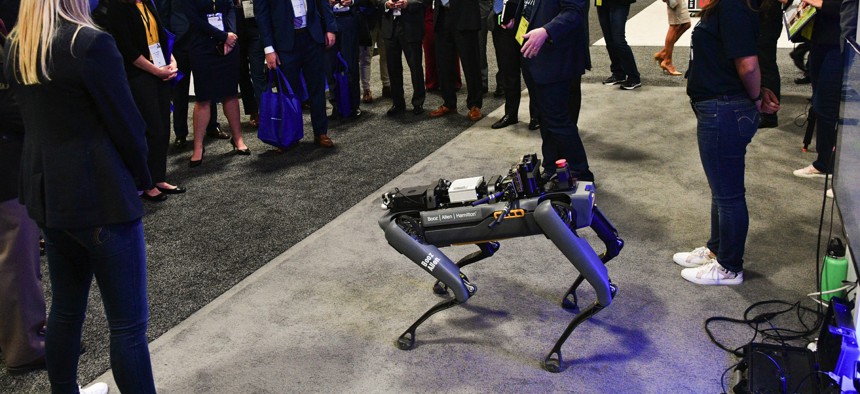
A quadruped robot at the 2021 Association of the U.S. Army conference in Washington, D.C. U.S. Army Combat Capabilities Development Command
Defense Business Brief: AUSA wrap; Vax required, even in Texas; Robot tanks, and more.
Like an armored personnel carrier being hauled away on a trailer, the two-month conference season is over. There was plenty of foot traffic at the Association of the U.S. Army annual conference in Washington this week, although it also seemed that there were far fewer soldiers than in years past.
Still, there were certainly more folks at the Washington Convention Center than at the Navy League’s Sea-Air-Space convention in August and the Air Force Association's Air, Space & Cyber conference in September—combined.
Most of the people I spoke with said that despite the larger crowds, they felt safer attending AUSA since it required attendees to wear masks and be vaccinated. By comparison, Sea-Air-Space was held just as indoor mask mandates were being reimposed around Washington, but did not require attendees to wear them. AFA did require masks and proof of vaccination or a negative COVID-19 test in order to attend.
AUSA and companies canceled most of their indoor dining activities; some companies held outdoor receptions at bars and restaurants. For now, it seems like the AUSA model will become the new norm for conferences during the pandemic, at least in the DC area.
What was interesting at the show? For the second consecutive month, a top Pentagon official questioned the role of hypersonic weapons. In September, it was AF Secretary Frank Kendall at AFA. This time, Heidi Shyu, the defense undersecretary for research and engineering, said companies need to cut the cost of these weapons.
“I'm very focused on trying to figure out how we can develop affordable hypersonic weapons. And so part of that ties into: do we have the right materials? Do we have the right test facilities to enable us to do this?” Shyu told Defense One Technology Editor Patrick Tucker. You can read Patrick’s entire interview with Shyu here.
Here’s what Capital Alpha Partners’ Byron Callan makes of Shyu’s remarks: “Conversations we had at AUSA confirmed that these weapons will primarily be used for ‘strategic’ targets—command posts and possibly air defense units—but Shyu’s comment raises the question of what will the DoD do instead to get at the problem of layered integrated air defense and offensive strike networks.”
Tracked robotic ground vehicles were shown off by General Dynamics Land Systems and Textron Systems. The GD vehicle is called TRX (pronounced T-Rex, like the dinosaur) and Textron’s is the Ripsaw. Here are some pictures.
New vertical-lift models and demonstrators were on display from Textron’s Bell and Lockheed Martin’s Sikorsky, who are pitching new aircraft for the Army’s Future Vertical Lift competitions. The Future Attack Reconnaissance Aircraft, FARA, will replace the Kiowa; the Future Long Range Assault Aircraft, or FLRAA, the Black Hawk.
Morgan Stanley’s Kristine Liwag wrote of these competitions: “We see industrial base concerns lowering the likelihood of DoD awarding both FLRAA and FARA to a single contractor. Another consideration for DoD centers around the future of tiltrotor technology. Namely, the Pentagon may view FLRAA as an opportunity to invest in next-generation tiltrotor technology through Bell’s V-280 Valor.”
Finally, we noted that the Army is focused on long-range missiles and artillery meant to counter China in the Pacific. With U.S. troops out of Afghanistan, there’s less of a need for bombs and missiles that were needed for surgical strikes and typically funded by the Pentagon’s war budget. Instead, these longer-range, China-and-Russia-focused munitions “could be a growth segment for missile makers,” writes Cowen and Company’s Roman Schweizer.
Making Moves
Heidi Grant, the director of the Defense Security Cooperation Agency, will leave the Pentagon on Nov. 6. She will then join Boeing where she will become vice president of business development leading the company’s defense, space and government services sales teams.
 From Defense One
From Defense One
Pentagon Orders Texas Contractors to Mandate Vaccines for Employees, Despite Governor's Ban // Marcus Weisgerber
The Defense Department says the federal contractor vaccine order supersedes state laws.
Head of Pentagon Foreign Arms Sales Division Stepping Down After 15 Months on the Job // Marcus Weisgerber
Heidi Grant was the first civilian to lead the Defense Security Cooperation Agency.
How China Is Planning For a Tech Decoupling // Alex Stone and Peter W. Singer
PLA strategists are already working on counters to anticipated U.S. moves.
Pentagon's Top Science Official Adds to Tech-Breakthrough Wishlist // Patrick Tucker
Heidi Shyu, R&D undersecretary, said she went looking for tech areas to trim—and found that some vital ones had been overlooked.
Defense Firms Pitch Arms, Gear to an Army Looking for Relevance in the Pacific // Marcus Weisgerber
On Wednesday, Lockheed Martin will attempt to fire a new weapon nearly 500 kilometers.
US Army to Stage Largest Robot Tank Experiment Ever // Patrick Tucker
Its lessons will inform the Army's next-gen-unmanned-vehicles plan to ask tech firms to deliver the brains and established firms to deliver the wheels.
The Inventor of the Taser and the Body Cam Wants to Put Them on Drones // Patrick Tucker
His pitch: non-lethal, robotically deployed Tasers can change the face of war.
How China Is Planning For a Tech Decoupling // Alex Stone and Peter W. Singer
PLA strategists are already working on counters to anticipated U.S. moves.
US Army Is Scrutinizing Itself, Must Change Swiftly to Face China, Secretary Says // Caitlin M. Kenney
"The future is a lot closer than some of us think," Christine Wormuth said at AUSA.




